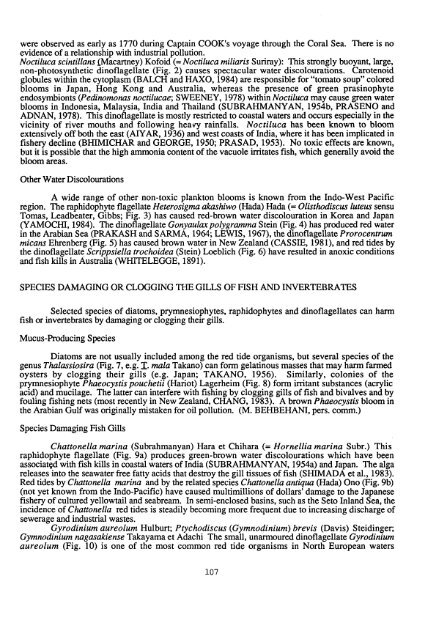139736eo.pdf (20MB) - Japan Oceanographic Data Center
139736eo.pdf (20MB) - Japan Oceanographic Data Center
139736eo.pdf (20MB) - Japan Oceanographic Data Center
- No tags were found...
Create successful ePaper yourself
Turn your PDF publications into a flip-book with our unique Google optimized e-Paper software.
were observed as early as 1770 during Captain COOK’S voyage through the Coral Sea. There is noevidence of a relationship with industrial pollution.Noctiluca scintillans [Macartney) Kofoid (= Noctiluca miliaris Sunray): This strongly buoyant, large,non-photosynthetic dinoflagellate (Fig. 2) causes spectacular water discolourations. Carotenoidglobules within the cytoplasm (BALCH and HAXO, 1984) are responsible for “tomato soup” coloredblooms in <strong>Japan</strong>, Hong Kong and Australia, whereas the presence of green prasinophyteendosymbionts (Pedinomonus noctilucae; SWEENEY, 1978) within Noctiluca may cause green waterblooms in Indonesia, Malaysia, India and Thailand (SUBRAHMANYAN, 1954b, PRASENO andADNAN, 1978). This dinoflagellate is mostly restricted to coastal waters and occurs especially in thevicinity of river mouths and following heavy rainfalls. Noctiluca has bee.n known to bloomextensively off both the east (AIYAR, 1936) and west coasts of India, where it has been implicated infishery decline (BHIMICHAR and GEORGE, 1950; PRASAD, 1953). No toxic effects are known,but it is possible that the high ammonia content of the vacuole irritates fish, which generally avoid thebloom areas.Other Water DiscolourationsA wide range of other non-toxic plankton blooms is known from the Indo-West Pacificregion. The raphidophyte flagellate Heterosigma akashiwo (Hada) Hada (= Olisthodiscus luteus sensuTomas, Leadbeater, Gibbs; Fig. 3) has caused red-brown water discolouration in Korea and <strong>Japan</strong>(YAMOCM, 1984). The dinoflagellate Gonyaulaxpolygramma Stein (Fig. 4) has produced red waterin the Arabian Sea (PRAKASH and SARMA, 1964; LEWIS, 1967), the dinoflagellate P rorocentrummicans Ehrenberg (Fig. 5) has caused brown water in New Zealand (CASSIE, 1981), and red tides bythe dinoflagellate Scrippsiella trochoidea (Stein) Loeblich (Fig. 6) have resulted in anoxic conditionsand fish kills in Australia (WHITELEGGE, 1891).SPECIES DAMAGING OR CLOGGING THE GILLS OF FISH AND INVERTEBRATESSelected species of diatoms, prymnesiophytes, raphidophytes and dinoflagellates can harmfish or invertebrates by damaging or clogging their gills.Mucus-Producing SpeciesDiatoms are not usually included among the red tide organisms, but several species of thegenus Thalassiosira (Fig. 7, e.g. 1. mala Takano) can form gelatinous masses that may harm farmedoysters by clogging their gills (e.g. <strong>Japan</strong>; TAKANO, 1956). Similarly, colonies of theprymnesiophyte Phaeocystis pouchetii (Hariot) Lagerheim (Fig. 8) form irritant substances (acrylicacid) and mucilage. The latter can interfere with fishing by clogging gills of fish and bivalves and byfouling fishing nets (most recently in New Zealand, CHANG, 1983). A brown Phaeocystis bloom inthe Arabian Gulf was originally mistaken for oil pollution. (M. BEHBEHANI, pers. comm.)Species Damaging Fish GillsChattonella marina (Subrahmanyan) Hara et Chihara (= Hornellia marina Subr.) Thisraphidophyte flagellate (Fig. 9a) produces green-brown water discolourations which have beenassociated with fish kills in coastal waters of India (SUBRAHMANYAN, 1954a) and <strong>Japan</strong>. The algareleases into the seawater free fatty acids that destroy the gill tissues of fish (SHIMADA et al., 1983).Red tides by Chattonella marina and by the related species Chattonella antiqua (Hada) Ono (Fig. 9b)(not yet known from the Indo-Pacific) have caused multimillions of dollars’ damage to the <strong>Japan</strong>esefishery of cultured yellowtail and seabream. In semi-enclosed basins, such as the Set0 Inland Sea, theincidence of Chattonella red tides is steadily becoming more frequent due to increasing discharge ofsewerage and industrial wastes.Gyrodinium aureolum Hulburt; Ptychodiscus (Gymnodinium) brevis (Davis) Steidinger;Gymnodinium nagasakiense Takayama et Adachi The small, unarmoured dinoflagellate Gyrodiniumaureolum (Fig. 10) is one of the most common red tide organisms in North European waters107
















